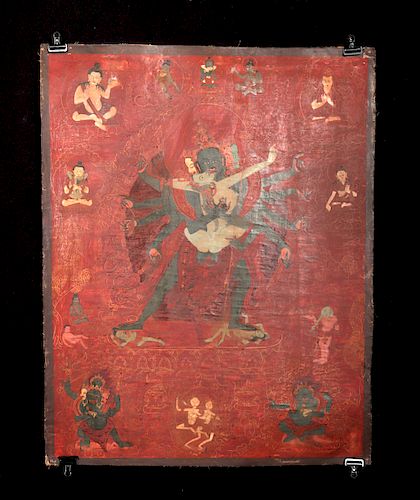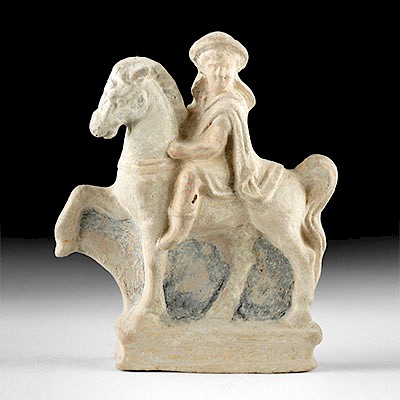Hand Painted 19th C. Tibetan Yab-Yum Tantric Thangka
Lot 82f
About Seller
Artemis Gallery
686 S Taylor Ave, Ste 106
Louisville, CO 80027
United States
Selling antiquities, ancient and ethnographic art online since 1993, Artemis Gallery specializes in Classical Antiquities (Egyptian, Greek, Roman, Near Eastern), Asian, Pre-Columbian, African / Tribal / Oceanographic art. Our extensive inventory includes pottery, stone, metal, wood, glass and textil...Read more
Categories
Estimate:
$1,200 - $1,500
Absentee vs Live bid
Two ways to bid:
- Leave a max absentee bid and the platform will bid on your behalf up to your maximum bid during the live auction.
- Bid live during the auction and your bids will be submitted real-time to the auctioneer.
Bid Increments
| Price | Bid Increment |
|---|---|
| $0 | $25 |
| $300 | $50 |
| $1,000 | $100 |
| $2,000 | $250 |
| $5,000 | $500 |
| $10,000 | $1,000 |
| $20,000 | $2,500 |
| $50,000 | $5,000 |
| $100,000 | $10,000 |
| $200,000 | $20,000 |
About Auction
By Artemis Gallery
May 9, 2019
Set Reminder
2019-05-09 10:00:00
2019-05-09 10:00:00
America/New_York
Bidsquare
Bidsquare : Ancient | Asian | Ethnographic
https://www.bidsquare.com/auctions/artemis-gallery/ancient-asian-ethnographic-4110
Featuring classical antiquities, ancient and ethnographic art from cultures encompassing the globe. All legally acquired, legal to sell. Satisfaction guaranteed. Convenient in-house shipping. Artemis Gallery info@artemisgallery.com
Featuring classical antiquities, ancient and ethnographic art from cultures encompassing the globe. All legally acquired, legal to sell. Satisfaction guaranteed. Convenient in-house shipping. Artemis Gallery info@artemisgallery.com
- Lot Description
Central Asia, Tibet, ca. 19th century CE. Hand-painted on a fine canvas, this thangka portrays a male deity in tantric yab-yum with his female consort - possibly Chakrasamvara and Vajravarahi. Yab-yum literally means "man-woman" and this tantric sensual union represents peace-making between spiritual polarities. As Thangka expert Ben Meulenbeld explains, yab-yum is a "non-orgasmic action that is meant to express the elimination of duality" (Buddhist Symbolism in Tibetan Thangkas, p. 73). It represents the male (symbolizing compassion and skillful means) in sexual union with the female (symbolizing wisdom and insight). The pair are surrounded by various deities including Ganesha as well as a skeleton couple at the bottom center, perhaps representing the patrons or their ancestors. All is delineated in a brilliant color palette of saturated brick red, slate blue, peach, and deep burgundy. Size: 22.75" L x 17.75" W (57.8 cm x 45.1 cm)
This type of painting is also known as a Paubha, the Newari word for a religious painting on a canvas. Buddhist Newari have traditionally used paubhas to aid in meditation or display above a home altar; oftentimes their commission was viewed as a devout act that would influence their kharma.
Provenance: private Hawaii, USA collection
All items legal to buy/sell under U.S. Statute covering cultural patrimony Code 2600, CHAPTER 14, and are guaranteed to be as described or your money back.
A Certificate of Authenticity will accompany all winning bids.
We ship worldwide and handle all shipping in-house for your convenience.
#146128Tiny perforations to corners from previous mounting. Normal surface wear with crease marks, scuffs, and scratches commensurate with age. Still imagery is finely delineated and strong. Verso of canvas has darkened with age.Condition
- Shipping Info
-
All shipping is handled in-house for your convenience. Your invoice from Artemis Gallery will include shipping calculation instructions. If in doubt, please inquire BEFORE bidding for estimated shipping costs for individual items.
-
- Buyer's Premium



 EUR
EUR CAD
CAD AUD
AUD GBP
GBP MXN
MXN HKD
HKD CNY
CNY MYR
MYR SEK
SEK SGD
SGD CHF
CHF THB
THB














